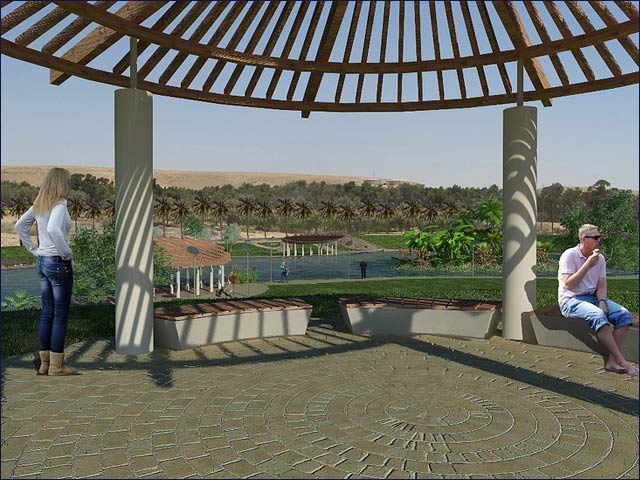By Sarah Carnvek
If Israel's first Prime Minister David Ben-Gurion were to pop by the city of Dimona today, he'd be thrilled to see this Negev community bringing his vision to fruition. Construction of a new green oasis that will cover 65 hectares (161 acres) of desert land is now underway.
The Keren Kayemeth LeIsrael-Jewish National Fund is investing $8 million in creating the new park, named after the man who dreamed of making the desert bloom.
It took 10 years of planning and permits approvals before KKL-JNF could finally break ground.
Park development plans include a manmade lake, recreational facilities, a promenade, footpaths, bike paths, playgrounds, sports fields and an amphitheater for cultural events.
“We are happy to take part in helping Dimona to develop,” said KKL-JNF team members. “We are realizing the vision of Ben-Gurion and the dream of the residents by turning the park into a vibrant center of life in the heart of the city.”
“The new and modern park, named after Ben-Gurion – which we will build together with the municipality and with the contributions of KKL-JNF and a community in Holland that adopted the park – will be the green lung of the city, will raise the quality of life and will completely change the culture of leisure time in Dimona,” KKL-JNF Chairman Efi Stenzler told the Jerusalem Post.
Stopover in Dimona
Dimona municipality officials say the park will serve as a “green lung” and recreation site for city residents as well as a tourist stopover for out-of-towners.
"It will be an all-in-one park," says Deputy Mayor Eli Bronstein. "It will be a place for recreation, tourism, sports and restaurants. There will be a lake, kayaks, an area for holiday bungalows, a section for restaurants and pubs, and an amphitheater that can hold up to 10,000 concert-goers."
 A simulated scene at the planned park
A simulated scene at the planned park
Photo courtesy of KKL-JNFDimona has a population of 40,000 residents, and the new surge of development there is aimed to increase the population to 60,000. The upgraded park is expected to provide 200 new jobs for Dimona residents.
Today, many people also visit Dimona to meet members of the African Hebrew Israelites community (also known as the Black Hebrews) – a religious group who believes their members are descendants of the Tribe of Judah. Visitors are invited to hear lectures, attend one of their famous gospel choir concerts and dine at one of their vegan restaurants.
Bronstein said his city, already a way station, wants to offer additional attractions to out-of-towners.
"There's a great atmosphere here and the park will make Dimona an even greater place. People come from all over Israel and we want to make sure that even more people will stop over," he said.
Forest to park
The park, which is expected to be ready in 18 months, is actually a KKL-JNF pine and eucalyptus forest planted in the 1970s that spreads out from the city of Dimona to the Dimona hills. The forest is surrounded by residential communities that popped up as Dimona's community grew.
“Today Ben-Gurion Forest is a green, tranquil spot in the heart of the desert. In Dimona, we don’t have the sea or other places to go to, like they do in the big cities in central Israel, so for us the forest is very important,” said Elisheva, a local resident.
With no access to the Mediterranean Sea for miles around, the Dimona lake, which will cost some $3 million to build, is set to be a base for boating and other water sports.
“Experience shows that the establishment of tourist spots for sports and leisure alongside other projects brings about a rise in property values and will attract many people to come and live in Dimona – as in Ben-Gurion’s vision to settle the Negev,” said Stenzler.